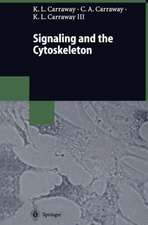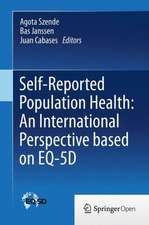Novel Insights into Adipose Cell Functions: Research and Perspectives in Endocrine Interactions
Editat de Karine Clément, Bruce M. Spiegelmanen Limba Engleză Hardback – 30 aug 2010
| Toate formatele și edițiile | Preț | Express |
|---|---|---|
| Paperback (1) | 1402.19 lei 6-8 săpt. | |
| Springer Berlin, Heidelberg – 23 aug 2016 | 1402.19 lei 6-8 săpt. | |
| Hardback (1) | 1409.33 lei 3-5 săpt. | |
| Springer Berlin, Heidelberg – 30 aug 2010 | 1409.33 lei 3-5 săpt. |
Preț: 1409.33 lei
Preț vechi: 1483.50 lei
-5% Nou
Puncte Express: 2114
Preț estimativ în valută:
269.70€ • 279.98$ • 224.89£
269.70€ • 279.98$ • 224.89£
Carte disponibilă
Livrare economică 01-15 martie
Preluare comenzi: 021 569.72.76
Specificații
ISBN-13: 9783642135163
ISBN-10: 3642135161
Pagini: 170
Ilustrații: XI, 147 p.
Dimensiuni: 155 x 235 x 15 mm
Greutate: 0.41 kg
Ediția:2010
Editura: Springer Berlin, Heidelberg
Colecția Springer
Seria Research and Perspectives in Endocrine Interactions
Locul publicării:Berlin, Heidelberg, Germany
ISBN-10: 3642135161
Pagini: 170
Ilustrații: XI, 147 p.
Dimensiuni: 155 x 235 x 15 mm
Greutate: 0.41 kg
Ediția:2010
Editura: Springer Berlin, Heidelberg
Colecția Springer
Seria Research and Perspectives in Endocrine Interactions
Locul publicării:Berlin, Heidelberg, Germany
Public țintă
ResearchCuprins
Pathological Alteration of Human Adipose Tissue in Obesity.- Dynamics of Human Adipose Tissue. Regulatory Mechanisms and Consequences for Fat Cells and the Whole Body.- Metabolism of Fatty Acids in Adipocytes.- The Role of Hypoxia in Adipocyte Function and Dysfunction.- Brown Adipose Tissue In Humans: A New Target for Anti-Obesity Therapy.- Adipose Tissue Dysfunction: A Multistep Process.- Fat Cell Progenitors: Origins and Plasticity.- Transcriptional Regulation of Brown and White Adipogenesis.- Transcriptional Control of Gene Expression in Different Adipose Tissue Depots.- Epigenetic Approaches to Adipose Biology.- Metabolic and Angiogenic Consequences of the Presence or Absence of UCP1.- Metabolic Responses to Weight Perturbation.- Understanding Causal Relationships in the Metabolic Syndrome: Recent Insights from Extreme Human Phenotypes.
Textul de pe ultima copertă
Obesity is considered as top at risk condition in the world and it is mandatory to identify the physiopathological causes involved in adipose tissue enlargement and related metabolic and cardiovascular health disorders. Environmental, behavioural, genetic, epigenetic and multiple biological factors interact to cause obesity. In this context adipose tissue depots have been under focus in the last decades and pivotal concepts have emerged from the studies of their complex biology. While the white adipose tissue (WAT) is the main energy repository in the body (mobilizing fatty acids according to body needs) thanks to white adipocyte properties, WAT is also a multicellular organ communicating with other body organs (brain, muscles, liver, pancreas, heart, vessels, etc…) via complex networks of endocrine signals. The discovery of leptin in 1994 led to recognize WAT as a master organ at the crossroad of a myriad of physiological interactions to control food intake, energy balance, glucose and lipid metabolism, immunity and reproduction. The phenotype, amount and biology of each WAT component are profoundly altered in human obesity. Adipose plasticity also accounts for the extraordinary capacity of adipose precursors to differentiate into functional cardiomyocytes, osteoblasts, haematopoietic and neural cells, a convenient property for regenerative medicine. Finally, while initially thought to exert a negligible role in humans, the discovery of brown adipose tissue in adults stimulates a novel interest for this tissue with high capacity to oxidize fatty acids
Caracteristici
Obesity is considered as top at risk condition in the world and it is mandatory to identify the physiopathological causes involved in adipose tissue enlargement and related metabolic and cardiovascular health disorders Environmental, behavioural, genetic, epigenetic and multiple biological factors interact to cause obesity In this context adipose tissue depots have been under focus in the last decades and pivotal concepts have emerged from the studies of their complex biology
























